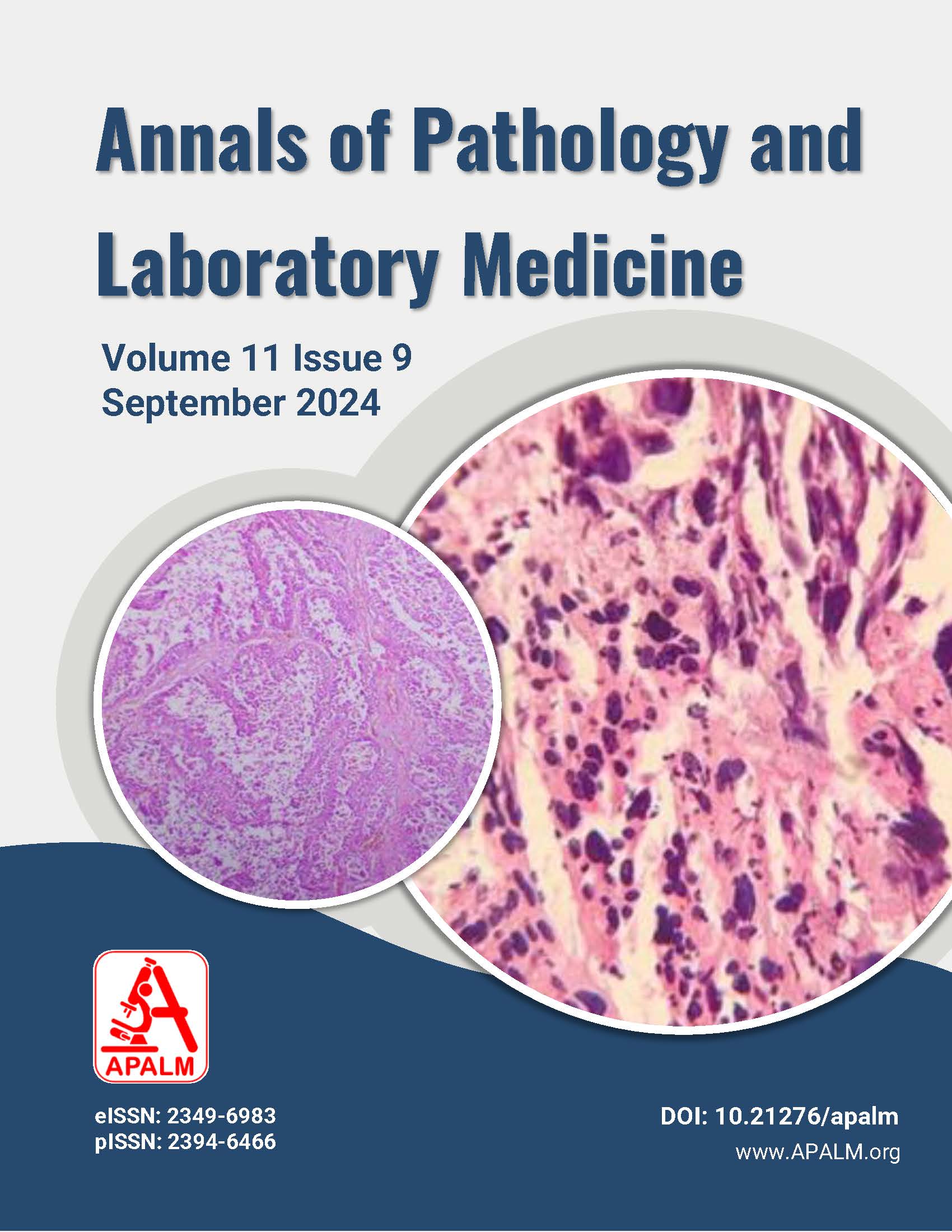Reporting of Lymph Node Fine Needle Aspiration Cytology by Application of Sydney System and Assessment of Prevalence of Malignancy
DOI:
https://doi.org/10.21276/apalm.3370Keywords:
Lymph node, cytology, Sydney System, malignant neoplasmsAbstract
Background: Fine needle aspiration cytology (FNAC) is a stepwise diagnostic approach that combines age, sex, site, clinical findings, multiplicity, ultrasound findings, low power pattern, high power pattern, and disease-specific diagnostic clues, including granulomas. The Sydney System for lymph node cytology classification and reporting has been developed to standardize the reporting language among cytopathologists and clinicians. We aim to apply the proposed Sydney System, categorize lymph node lesions accordingly, and determine the prevalence of different types of malignancies.
Materials and Methods: This was a cross-sectional study of lymph node cytology conducted from July 2022 to June 2023 in the Department of Pathology at Gauhati Medical College and Hospital. The results were reported according to the Sydney System into five groups, from L1 to L5.
Results: Out of the 555 cases, the cervical group of lymph nodes was the most commonly affected (72.9%). The male-to-female (M:F) ratio was 1.61. The most commonly affected age group was 41-50 years. A total of 54.41% of cases were categorized under L2, followed by 28.29% of cases under L5. Metastatic squamous cell carcinoma (SCC) was the most commonly encountered neoplastic lesion. The prevalence of lymphoma was 2.16% in the present study. The prevalence of malignancy was higher in males compared to females.
Conclusion: The Sydney System of reporting and classifying lymph node cytology can help achieve uniformity and reproducibility, leading to fairly accurate risk assessments of malignancy for further clinical management.
References
Choi AH, Bolaris M, Nguyen DK, Panosyan EH, Lasky JL, Duane GB. Clinicopathological correlation in an atypical presentation of lymphadenopathy with review of literature. Am J Clin Pathol. 2015;143:749-54.
Orell SR, Sterrett GF. Orell & Sterrett’s fine needle aspiration cytology. 5th ed.
Keith VE, Harsharan SK, Jerald GZ. Fine needle aspiration biopsy of lymph nodes in the modern era: reactive lymphadenopathies. CytoJournal. 2007;12:27-35.
Fine needle aspiration biopsy: role in diagnosis of pediatric head and neck masses. Int J Pediatr Otorhinolaryngol. 2008;72:1547-53.
Sreelekshmi, Raman J, Joseph TP. Structured reporting of lymph node cytopathology using the 2020 Sydney System Guidelines: a retrospective study. Natl J Lab Med. 2023;12(2)
AI-Abbadi MA, Barroca H, Bode-Lesniewska B, Calaminici M, Caraway NP, Chhieng DF, et al. A proposal for the performance, classification, and reporting of lymph node fine-needle aspiration cytopathology: the Sydney System. Acta Cytol. 2020;64:306-22.
Pandya D, Bhetariya B, Gupta P. Diagnostic utility of proposed Sydney System of lymph node by fine needle aspiration cytology: a cross-sectional study. J Clin Diagn Res. 2022;16(12)
Gupta P, Gupta N, Kumar P, Bhardwaj S, Srinivasan R, Dey P, et al. Assessment of risk of malignancy by application of the proposed Sydney System for classification and reporting lymph node cytopathology. Cancer Cytopathol. 2021 Sep;129(9):701-18.
Vigliar E, Acanfora G, Laccario A, Mascolo M, Russo D, Scalia G, et al. A novel approach to classification and reporting of lymph node fine-needle cytology: application of the proposed Sydney System. Diagnostics. 2021;11(8):1314.
Newaskar V, Verma D, Balani S, Malik R, Khan A. Application of the novel Sydney System in classification and reporting of lymph node fine needle aspiration cytology. Int J Sci Res. 2022;11:9.
Shakya G, Malla S, Shakya KN, Shrestha R. A study of FNAC of cervical lymph nodes. J Nepal Health Res Counc. 2009;7(1):1-5.
Sharma RI, Dharaiya CM. Study of fine needle aspiration cytology of lymphadenopathy in a tertiary care centre of Ahmedabad, Gujarat. Trop J Pathol Microbiol. 2018;4(3):258-64.
Alam K, Hiremath SS, Patil SB. Fine needle aspiration cytology, a handy tool for metastatic lymphadenopathy. Int J Pathol. 2010;10(2).
Kadam SA, Miskin AT, Dombale VD. Role of FNAC in study of cytomorphological patterns in cervical lymph node. Med Innov. 2020;9(2).
Krishnaswamy J, Rahaman K, Reshma S. A clinical study of reliability of fine needle aspiration cytology as a diagnostic tool in cervical lymphadenopathy. Int Surg J. 2017 Oct;4(10):3409-13.
Nikethan B, GV N, Hiremath SS, Patil SB. Role of fine needle aspiration cytology in the evaluation of the etiology of lymphadenopathy. Indian J Pathol Oncol. 2016;3(4):548-51.
Sharma P, Deb T, Ray JG, Singh AK, Gupta G, Das A, et al. Oral squamous cell carcinoma profile in North-Eastern regions of India from habits to histopathology: a hospital-based study. Natl J Maxillofac Surg. 2018 Jun;9(1):56-60.
Downloads
Published
Issue
Section
License
Copyright (c) 2024 Shriya Roy, Junu Devi, Daljeet Kaur

This work is licensed under a Creative Commons Attribution 4.0 International License.
Authors who publish with this journal agree to the following terms:
- Authors retain copyright and grant the journal right of first publication with the work simultaneously licensed under a Creative Commons Attribution License that allows others to share the work with an acknowledgement of the work's authorship and initial publication in this journal.
- Authors are able to enter into separate, additional contractual arrangements for the non-exclusive distribution of the journal's published version of the work (e.g., post it to an institutional repository or publish it in a book), with an acknowledgement of its initial publication in this journal.
- Authors are permitted and encouraged to post their work online (e.g., in institutional repositories or on their website) prior to and during the submission process, as it can lead to productive exchanges, as well as earlier and greater citation of published work (See The Effect of Open Access at http://opcit.eprints.org/oacitation-biblio.html).










